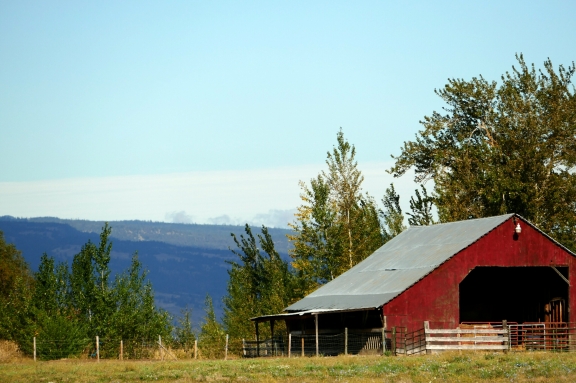
Note: Post edited 10/2/15. Removed three examples in first photo section to make post less cluttered and added 35 mm focal length equivalents to photo captions.
Cee has started a new weekly challenge on her blog called Compose Yourself, and the subject will be photographic composition. She briefly discussed a few different topics in her first post, but the challenge is to post pictures of your focal length comfort zone, then post pictures of attempts to get out of that zone and discuss it.
I don’t really fit into that part of the challenge, because I don’t think I have a focal length comfort zone. I adore zoom lenses and whenever I’m taking photos I give mine a good workout. I like closeups, I like wide-angle vistas, and lots of the between too, as these first examples show.
Though I’ll note it’s rare I’m in a situation where I feel I can freely use my lens at its widest angle. In the city, or even out in farmland, it seems like there’s always something I want to avoid like a fence, power pole, or vehicle that will only add clutter or distraction, so I frequently have to zoom in at least a little. It can get frustrating at times.
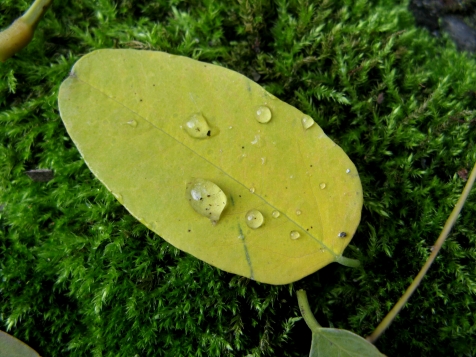
Macro setting. November 2013, after it rained.
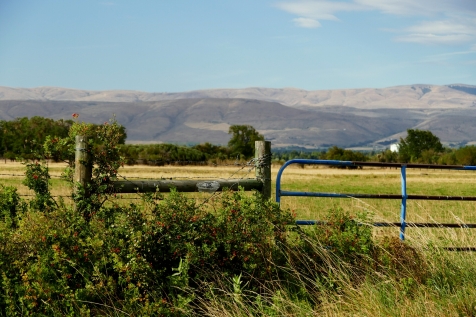
Focal length 140 mm. Near Ellensburg, Washington – August 2015.
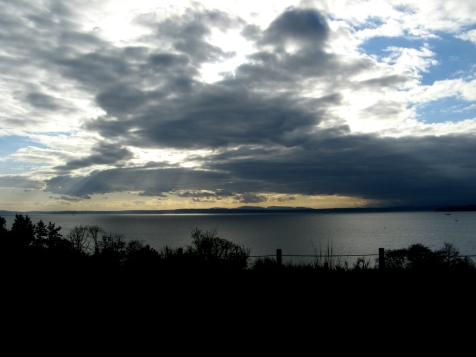
Focal length 24 mm. Puget Sound from Richmond Beach Saltwater Park – February 2015.
I was eighteen when I bought my 35 mm film SLR camera and I did have a comfort zone. It was a bad one. I liked macro photography, but for the rest I was stuck in a rut of the uninteresting middle. It took a long time before I started learning to step forward or back in order to take more visually appealing photos. (I only had a 50 mm lens to start with, so I had to move, rather than zoom.)
However, even though I understand more about composition now, it doesn’t mean I always, or even usually, get it right! I can’t count the number of times I’m looking at photos after downloading them to my computer and think, “Nuts! I should have X,” where X is either getting in tighter or going wider.
To compensate for my unending tendency to hastily compose, I’ve tried to get into the habit of taking more than one photo, using different zoom amounts in the hopes of getting a picture that is just right. But I don’t always follow through, and still end up with a lot of those nuts moments. (Cropping after can help, but it’s always best to get it right in-camera.)
Cee’s Compose Yourself Bonus Challenge this week is to post pictures of the same subject at different focal lengths, then say which you like best and why. My photos for the bonus challenge are an example of when I did think to take several shots recently. (They aren’t particularly good photos, but serve as good examples.)

Focal length 41 mm. The fence in the foreground and the oddly blurry clouds above really detract. (Taken near Ellensburg, Washington – August 2015.)

Focal length 160 mm. Okay, but more factual than visually appealing.
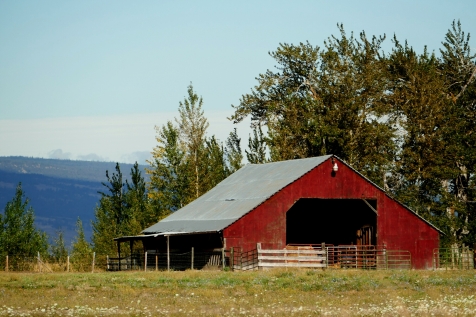
Focal length 370 mm. Much better.
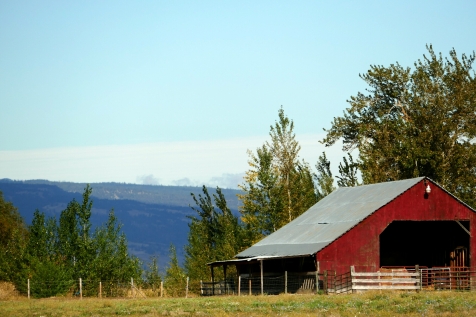
Same exact amount of zoom as the previous photo, just framed differently.
The final photo is my favorite of the four. Zooming in enough to only have one building in the frame makes it feel more intimate. And surprisingly to me, chopping off part of the barn makes it visually more interesting I think. I was near the limit of my zoom, or it would have been good to have an even tighter shot to compare.
Wonderful post for this first week. You are spot on. I like your 4th photo too. Wonderful eye. Thanks ever so much for playing.
LikeLike
Thanks, Cee. I like the new challenge. You made me think a lot this time.
LikeLike
I wouldn’t have thought to cut part of the barn off but it does make the photo more visually appealing somehow.
I think most landscapes in our area are just too busy and crowded for wide angle photos because, like you, there’s always something I’m having to zoom in to avoid! I love our trees but I often find myself a little envious of other people’s photos of rolling hills and farms. You’ve got some beautiful photos here though. I especially love the ones of the sound at dusk.
LikeLike
I normally wouldn’t have thought of cutting of the barn either. I tend to get too literal at the expense of art. And yes, avoiding things is tough! I can’t count the number of times I come back home and realize I need to crop out a pole or tree branch! I really need to slow down and LOOK, but easier said than done for me.
LikeLike
Same here! Then once I get home I wonder why I didn’t take the time to get more shots from different angles or at least check my ISO! 🙂
LikeLike
Yep. And don’t even get me started on checking ISO. After starting with a few pics in deep morning shade, I spent the rest of the day taking pics in bright sunlight with ISO set at 400 at Volunteer Park the other day. (sigh)
LikeLike
Great views of the red barn and the sound.
LikeLike
Thanks!
LikeLike
Hi I’m pretty new to photography and was wondering why the 160mm photo seemed unappealing? Does it have something to do with the right barn?
LikeLike
Hi! It’s not that it’s completely unappealing, but it’s more like, here’s a photo of a couple barns. As a travel diary type of photo it’s fine as a representation of things I saw. But I think there’s a kind of emotional distance to it, and the one with just the single barn taking up more of the frame has more immediacy. I’m really not very good at trying to put these kinds of things into words.
I recommend doing the exercise yourself with some subjects you choose. For practice it doesn’t even need to be a great subject, since you’re just seeing what affect getting closer and farther away has on composition. Try different zoom lengths, or moving closer and farther away with your feet. Then look at your photos to see which catch your interest the most. The answer will be different with different subjects and different lighting conditions.
LikeLiked by 1 person
Thanks for the explanation. I can’t wait to try my hand at it sometime this week
LikeLike
Pingback: CCY: Week #1 Gold Star Award and Features | Cee's Photography
Congratulations! You have been featured on CCY Week #1.
http://ceenphotography.com/2015/10/07/ccy-week-1-gold-star-award-and-features/
I hope you have a terrific week.
LikeLike
Thanks, Cee!
LikeLike
The pleasure was all mine. 😀
LikeLike
I love the wide open spaces
LikeLike
Pingback: Cee’s Weekly Wrap Up – October 10, 2015 and WPC Happy Place | Cee's Photography
I started with just a 50mm lens, too, when I had my first SLR. I took my first photography class then, too, and learned that it’s best to learn with a 50mm first since you have to do more work moving around to get the shot you want.
LikeLike
I agree it’s better to learn that way. I do a lot of lazy cheating with my zoom. Heh.
LikeLike
I am starting out again, I never did complete Cee’s photo class, so I am learning from your post. I actually do not really understand what focal length means, 40mm, 120mm I will research this. I love this post though, with the different focal lengths (even though I do not understand, I have an intuitive sense of what you are talking about) of the same photo. I am so glad I can start all over again, just with Lesson One. At any rate, this was a great post and I am glad it is still online.
LikeLike
Thanks for your comments. In average person terms focal length refers to how much magnification your lens has. In practical terms it’s connected to field of view. In other words, when you snap a photo are you getting a big wide picture or just a small part of what you see with your eyes.
The numbers can be easy to understand if you just remember that small numbers mean you see more (and objects are distant/small) and high numbers mean you see less (and distant objects can be seen in great detail). Small numbers (i.e. 16 mm) are referred to as wide angle and large numbers (i.e. 150 mm) are telephoto.
The main lens that most cameras came with in film days was a 50 mm lens. It’s in between wide angle and telephoto, and most closly approximates in photos how close/far things look with the naked eye from the position the photo was taken. So you can use that 50 mm number as a starting point to judge focal lengths and from where to start with using your camera.
When it comes to digital photography things get tricky because sensors (the part of the camera that captures the image) come in several different sizes. Full frame DSLR cameras have a sensor that closely approximates the old standard 35 mm film. Most other types of cameras have smaller sensors, even cameras with interchangeable lenses. (The larger a sensor is the better quality photo it captures, usually.)
Any sensor smaller than full frame is considered a cropped sensor. My camera has a 1″ sensor, which is quite a bit smaller than full frame, but larger than most point and shoot cameras.
The reason I’m bringing up sensor size is because it relates directly to focal length on lenses. A 50 mm lens on a full frame camera is not the same focal length as a 50 mm lens on a small sensor camera. Confusing, I know!
But to make it less confusing, and the only thing you really need to remember, is that manufacturers will usually state the 35mm film camera equivalent of a lens. That gives everyone a set standard that is useful in making comparisons regardless of the sensor size of your camera.
As a real world example, when my camera lens is at its widest angle the focal length is 9 mm, which is kinda meaningless to anyone who doesn’t have a camera with the same sensor size as mine. That translates to 24 mm using the 35mm film equivalent, and that number is more meaningful and easier to understand in general.
I hope this helps and good luck with your photography adventures!
LikeLike